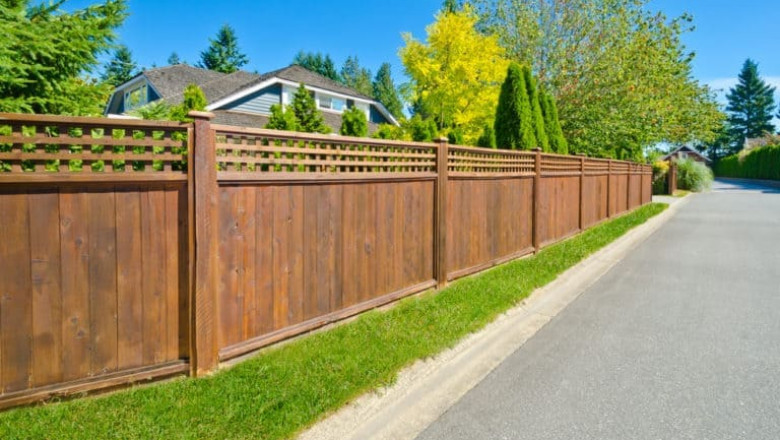views
When it comes to selecting the right fencing for your property, the decision often boils down to two popular materials: vinyl and wood. Both options offer distinct advantages, but they also come with their own considerations. In this article, we’ll explore the key differences between vinyl fencing and traditional wood fencing to help homeowners and builders make an informed decision.
Durability and Longevity
Vinyl Fencing
Vinyl fencing is known for its impressive durability. Made from polyvinyl chloride (PVC), vinyl fences are resistant to weather conditions, rot, pests, and decay. Unlike wood, vinyl does not warp, crack, or splinter, making it an excellent long-term investment. Most vinyl fences come with warranties that last decades, showcasing their ability to withstand time with minimal deterioration.
Traditional Wood Fencing
Wood fencing, while classic and charming, requires more maintenance to remain in good condition. Over time, wood can suffer from rot, insect infestations, and warping due to moisture and temperature fluctuations. Treated wood varieties, such as cedar and redwood, offer better resistance against decay, but they still need regular upkeep to extend their lifespan.
Maintenance Requirements
Vinyl Fencing
One of the standout benefits of vinyl fencing is its low-maintenance nature. Unlike wood, vinyl does not require painting, staining, or sealing. Cleaning a vinyl fence is as simple as using a garden hose or mild soap and water to remove dirt and debris. This makes it an ideal choice for homeowners who prefer a hassle-free fencing solution.
Traditional Wood Fencing
Wood fencing demands routine maintenance to preserve its appearance and structural integrity. Homeowners must apply sealants, stains, or paint every few years to protect against moisture and UV damage. Additionally, periodic inspections for signs of rot or insect infestation are necessary, requiring more time and effort compared to vinyl fencing.
Aesthetic Appeal and Customization
Vinyl Fencing
While vinyl fencing offers a sleek and modern look, it comes in limited colors and styles. Manufacturers provide various designs, including privacy, picket, and ranch-style fences, but customization options are somewhat restricted. Unlike wood, vinyl cannot be easily modified once installed, making it less adaptable to specific aesthetic preferences.
Traditional Wood Fencing
Wood fencing is highly customizable, allowing homeowners to choose from various designs, stains, and paint colors. Whether aiming for a rustic, contemporary, or traditional look, wood offers unmatched flexibility. It can also be cut and shaped on-site, making it easier to tailor the fence to a property’s specific needs.
Cost Considerations
Vinyl Fencing
Vinyl fencing has a higher upfront cost compared to wood. However, since it requires little to no maintenance and lasts for decades, it often proves to be a cost-effective choice in the long run. Homeowners looking for a long-term investment may find vinyl fencing to be the better financial decision.
Traditional Wood Fencing
Wood fencing is initially more affordable, making it an attractive option for those on a budget. However, the costs of staining, sealing, and potential repairs over time can add up. When factoring in maintenance expenses, wood fencing may become costlier than vinyl over its lifespan.
Environmental Impact
Vinyl Fencing
Vinyl fencing is made from synthetic materials, which may raise concerns about its environmental footprint. However, some manufacturers produce recyclable vinyl, making it a more eco-friendly option. The long lifespan of vinyl fencing also means less frequent replacements, reducing overall waste.
Traditional Wood Fencing
Wood fencing is a natural and renewable resource, which makes it an eco-friendly choice when sourced from sustainably managed forests. However, the use of chemical treatments and stains can impact the environment. Choosing untreated or naturally resistant wood species can help minimize environmental concerns.
Installation Process
Vinyl Fencing
Vinyl fencing often comes in pre-assembled panels, making installation quicker and easier compared to wood. Many homeowners opt for professional installation to ensure stability, but DIY installation is also possible with proper planning and tools.
Traditional Wood Fencing
Wood fencing requires more labor-intensive installation, as each post and panel must be measured, cut, and secured. Depending on the design and wood type, installation may take longer and require specialized skills. While professionals can ensure proper alignment and durability, DIYers may find wood fencing more challenging to install than vinyl.
Which One Should You Choose?
Choose Vinyl Fencing If:
- You prefer a low-maintenance, long-lasting fence.
- You want a clean, modern look with minimal upkeep.
- You’re willing to invest more upfront for long-term savings.
Choose Traditional Wood Fencing If:
- You appreciate the natural beauty and customizable features of wood.
- You don’t mind performing regular maintenance.
- You have a limited budget and are comfortable with potential upkeep costs.
Final Thoughts
Both vinyl fencing and traditional wood fencing have their strengths and weaknesses. The best choice ultimately depends on factors such as budget, maintenance preference, aesthetic goals, and long-term durability. For those seeking a virtually maintenance-free solution with long-lasting appeal, vinyl is a solid investment. However, if customization and natural beauty are top priorities, traditional wood fencing remains a timeless option.
Before making a decision, consider consulting a fencing expert to determine which material best suits your specific property needs and design vision.
info: https://gstarboard.com













Comments
0 comment